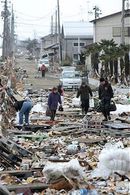 When the West looks at Japan, it’s strange that so much attention falls on the Japanese
nuclear plants when the tsunami – water, mud and debris – was by far the greater killer. The picture of the tsunami damage is becoming clearer all the time. Here, from my vantage point
of Singapore, is the latest summary:
When the West looks at Japan, it’s strange that so much attention falls on the Japanese
nuclear plants when the tsunami – water, mud and debris – was by far the greater killer. The picture of the tsunami damage is becoming clearer all the time. Here, from my vantage point
of Singapore, is the latest summary:
Deaths: 11,938 people are dead. More than 7,000 of them died in Miyagi prefecture, over 3,000 in Iwate and 1,000 in Fukushima. 15,478 people are missing. The death toll rises daily. Searches are on for orphans.
Displacement: 164,200 people have been evacuated due to the tsunami and live in makeshift shelters. Only one-third of these are regularly served warm food, says a Mainichi survey. 220,000 homes still do not have running water and 170,000 are without power. The weather is expected to remain cool through April.
Destruction: The tsunami ravaged Japan’s northeastern region, affecting some 645 km of coastline. That’s 5 percent of the UK’s coastline, and more than three times that of the city-state of Singapore. The waves crashed 10 km inland. 45,751 buildings have been destroyed; the total including partially destroyed buildings is 151,000. At least 23 railway stations in the Tohoku region have been washed away. Entire forests have been felled: in Rikuzentakata, 70,000 trees were razed except for one. The tsunami has also curtailed power generation – offices and companies around Tokyo may cut electricity usage by as much as a quarter.
Economic cost: The cost of the tsunami damage may run to $309 billion, says the Japan government. To put it crudely, this equates to four Katrinas and makes it the most expensive natural catastrophe in history. Japan’s stock market index is still down, by about 5 percent, from the day the disaster struck. Japan is already $10 trillion in debt, and its ability to keep borrowing at low interest rates may be hurt. Japanese government bonds have fallen for two weeks, with investors reluctant to bid aggressively. The nation’s Purchasing Managers’ Index posted its biggest slide since 2001, sparking fears of a recession. The Tankan survey of business confidence will be re-released on Monday, to take into account post-tsunami responses. New car sales have plummeted by more than a third. (Honda may suspend UK production due to shortage of components.) Shipping lanes are threatened. Hundreds of thousands of people are potentially jobless, not to mention farmers who may lose their livelihoods as fear of radioactive produce spreads.
Loss of certainty: Life in Japan is slowly getting back to normal, but there’s fragility in the air. The neon lights of Shinjuku and Ginza have been switched off. Candidates for Tokyo’s upcoming governorship elections have campaigned without high-decibel speakers as a mark of respect for tsunami victims. Japan’s famed cherry blossom festival, to celebrate Spring and renewal, has been cancelled.
Of course Japan will rise again. Investors like Warren Buffett have already been giving their vote of confidence. Reconstruction may even kick-start a moribund economy. Japan is strong, and will emerge bigger and better than before. But the shock, the loss, the grief, the repair – she will never be the same again.






Comments